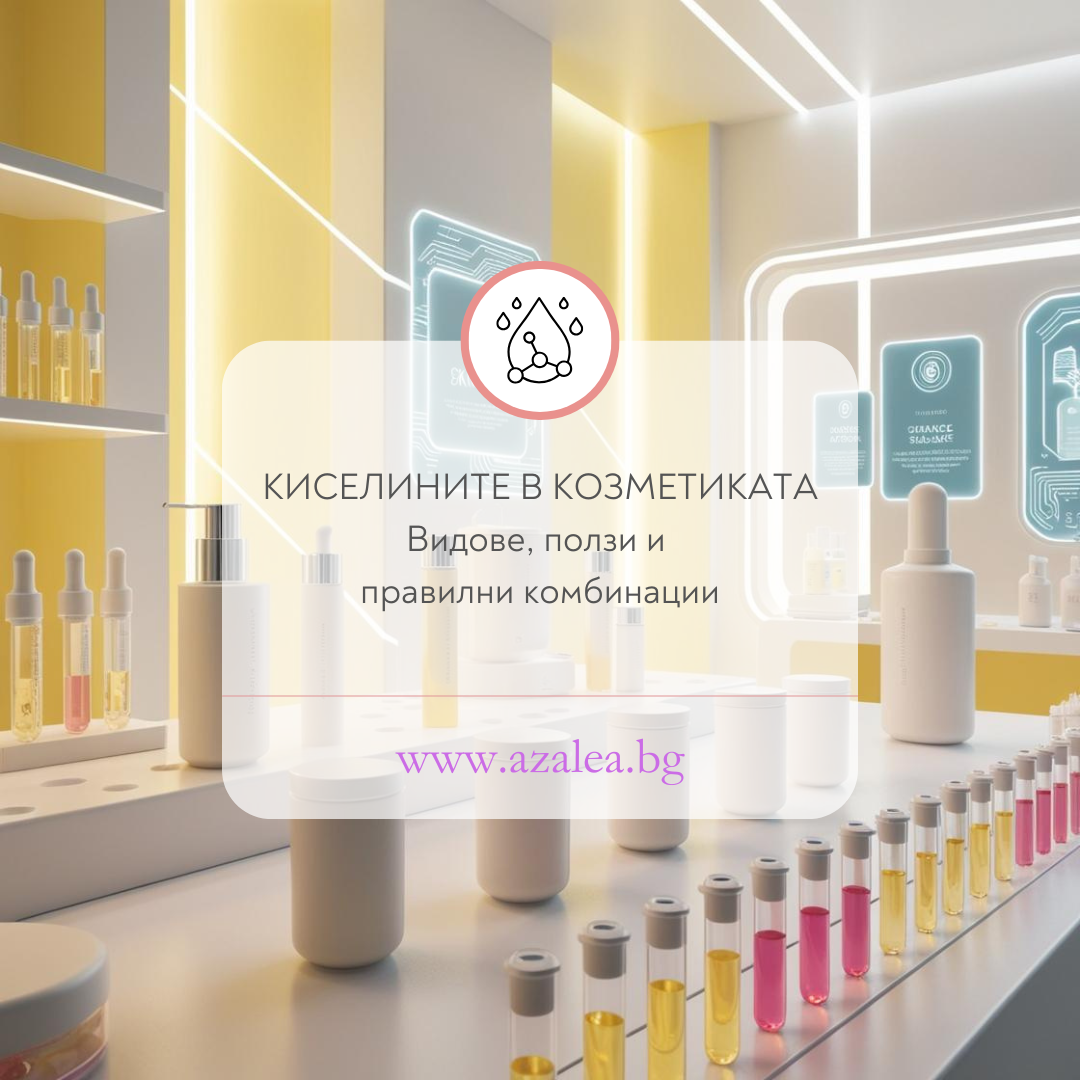
Acids in cosmetics: Types, benefits and correct combinations
Share
Acids are powerful active ingredients in cosmetics that can transform the skin by exfoliating, hydrating, brightening the complexion, and even fighting acne and wrinkles. However, not all acids are created equal – some are suitable for daily use, while others require careful combination and application. In this article, we will look at the most popular acids in cosmetics, their properties, how to use them, and how to combine them correctly.
Types of acids in cosmetics
1. Alpha-hydroxy acids (AHAs) – for radiant and smooth skin
AHAs are water-soluble acids that work primarily on the surface of the skin, removing dead cells and improving texture. They are a great choice for dry and mature skin.
🔹 Glycolic Acid – The most powerful AHA, extracted from sugar cane. Stimulates collagen production, reduces hyperpigmentation, and smoothes fine lines.
🔹 Lactic Acid – Gentler than glycolic acid, but just as effective at exfoliating and hydrating. Ideal for sensitive and dry skin.
🔹 Mandelic Acid – Its large molecules penetrate slowly, making it suitable for sensitive skin and people with rosacea.
🔹 Citric Acid – In addition to exfoliating, it has antioxidant properties and regulates the pH balance of the skin.
✅ Alpha-hydroxy acids combine well with: Hyaluronic acid, niacinamide, ceramides.
❌ Do not combine with: Vitamin C, other exfoliating acids (such as BHA), retinol.
2. Beta-hydroxy acids (BHAs) – for oily and problematic skin
BHAs are fat-soluble, which means they penetrate deeper into pores and help with acne and oiliness.
🔹 Salicylic Acid – The most well-known BHA, it dissolves excess sebum and unclogs pores, reducing blackheads and pimples. It also has anti-inflammatory properties.
✅ Combines well with: Niacinamide, zinc, hyaluronic acid.
❌ Do not combine with: AHAs, retinol, vitamin C (to avoid skin irritation).
3. Polyhydroxy acids (PHAs) – gentle exfoliation for sensitive skin
PHAs have larger molecules and act more slowly, making them gentler and suitable for sensitive skin.
🔹 Gluconolactone – Excellent for people with rosacea, eczema and very sensitive skin. Hydrates and strengthens the skin barrier.
🔹 Lactobionic Acid – It has strong antioxidant properties and protects the skin from harmful external factors.
✅ Combine well with: AHAs, BHA, hyaluronic acid.
❌ Do not combine with: High concentrations of vitamin C or retinoids.
4. Hyaluronic Acid – super hydration
This acid does not exfoliate, but attracts and retains moisture in the skin. It is suitable for all skin types, including sensitive.
✅ Combines well with: All acids, retinol, peptides, vitamin C.
❌ No incompatibilities.
5. Azelaic Acid – against redness and pigmentation
This unique acid has antibacterial, anti-inflammatory and brightening properties. It is suitable for people with acne, rosacea and hyperpigmentation. We recommend the Nineless 10% Azelaic Acid Face Serum .
✅ Combines well with: Niacinamide, hyaluronic acid, retinol (in low concentrations).
❌ Do not combine with: High concentrations of AHAs and BHAs.
6. Tranexamic Acid – against dark spots and melasma
Known for its ability to reduce age spots by blocking the process of melanogenesis.
✅ Combines well with: Vitamin C, niacinamide, hyaluronic acid.
❌ Do not combine with: High concentrations of exfoliating acids.
7. Kojic Acid - inhibits the enzyme tyrosinase, which is responsible for the production of melanin. This makes it effective against dark spots, melasma and acne scars. Check out NINELESS B-Boost 1% Kojic Acid Serum - a highly effective serum designed to lighten dark spots, reduce hyperpigmentation and even out skin tone.
✅ Good combinations: With vitamin C, niacinamide, azelaic acid.
❌ Do not combine with: High concentrations of exfoliating acids to avoid irritating the skin.
How to properly combine acids?
✔ Safe combinations:
• Hyaluronic acid + any other acid
• AHAs + PHAs
• BHA + niacinamide
• Vitamin C + tranexamic acid
❌ Risky combinations (may cause irritation):
• AHAs + BHAs (double exfoliation may be overkill)
• AHAs or BHAs + retinol
• Vitamin C + AHAs/BHAs (may irritate skin)
Why do some acids not combine but occur together in products?
We often hear that certain acids should not be used together, but they are nevertheless found in combined formulas. For example, in the great pore minimizing serum with AHA, BHA and PHA medicube Zero Pore One Day Serum . The reason is in the way these cosmetic products are formulated.
How do these formulas work?
1. Controlled pH – When manufacturers create a formula with different acids, they balance the pH to reduce the risk of irritation. For example, AHAs and BHAs can be combined in low concentrations at a controlled pH.
2. Encapsulation of active ingredients – Some acids are encapsulated to release gradually, which prevents irritation.
3. Adding soothing ingredients – Formulas often contain niacinamide, panthenol, or centella asiatica, which reduce the risk of irritation.
4. Different molecular sizes – For example, glycolic and mandelic acid can be in one product because they penetrate the skin at different rates.
How to introduce acids into our routine?
1. Start with low concentrations – if you have never used acids, try a lower concentration 1-2 times a week.
2. Use sunscreen – exfoliating acids make the skin more sensitive to UV rays.
3. Listen to your skin – if you experience dryness, burning or redness, reduce the frequency of use.
Conclusion
Acids are a powerful tool in skin care, but they require the right approach and combination. If used wisely, they can make your skin smoother, brighter, and healthier. Always check the compatibility of ingredients and don't forget about hydration and sun protection!
💖 Find the best products for your skin at azalea.bg and create your perfect routine!